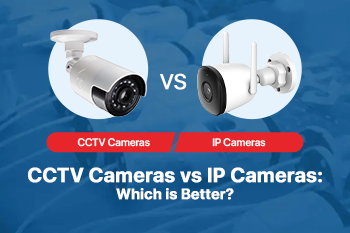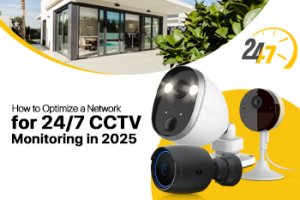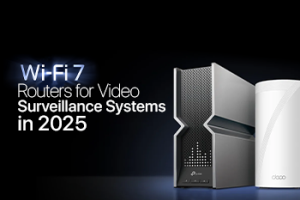CCTV Cameras vs IP Cameras: Which is Better?


Surveillance cameras have become an integral part of households, both urban and semi-urban, as well as rural countryside. They are popular for multiple obvious reasons: their proven effectiveness in crime deterrence, crime reduction, remote monitoring, insurance benefits, and more. Multiple studies show that the installation of feature-packed security cameras can lead to 60% to 70% crime deterrence, up to 50% decrease in employee theft and shoplifting, up to 20% increase in employee productivity, 50% faster incident resolution, and up to 30% drop in vandalism and public disturbances.
The latest trend in the deployment of cameras for 24/7 security and surveillance is the smart home integration. This integration has added more to the usability of security cameras, allowing users to enjoy remote monitoring, automated responses, integrated alerts, voice controls, and a unified control interface. Given the significance of security cameras, it has become very important for urban and semi-urban residents in the USA to choose security systems that best meet their needs.
The installation of an incompatible surveillance and security system can lead to the wastage of precious resources. However, when you decide to navigate the market, you often encounter two terms: IP cameras and CCTV cameras. Knowing the differences between the two can help you make a well-informed decision to protect your property, investment, and family. This blog serves this purpose precisely.
Are you ready to dive in? Let’s get the ball rolling!
What Are IP Security & Surveillance Cameras?
IP security cameras, or Internet Protocol, also dubbed as network cameras, are those surveillance cameras that transmit video data through the Internet or a local area network. These are digital cameras that are part of modern surveillance infrastructure, and they allow live feed to be seen either through websites or through mobile applications on smartphones.
IP cameras are capable of suppressing captured data, making it convenient to both view the footage as well as transmit the video data. Sometimes, users confuse IP cameras with wireless CCTV cameras; however, both are different.
How IP Cameras Work:
Simply speaking, network cameras capture footage and convert it into a digital format. These digital signals are then transmitted through a network, and footage is stored in a Network Video Recorder or NVR); alternatively, cloud storage can also be used.
If IP cameras support Power Over Ethernet or PoE, they can transmit both data and power through the same Cat cable, allowing users to save cost and reduce cable clutter.
Pros of Installing an IP Security Camera in the USA:
These network-based cameras offer multiple advantages. For instance:
-
If these cameras are not wireless, you can use Cat5 or Cat6 cables for connection.
-
Power over Ethernet, or PoE support, can help you save costs and reduce cable clutter.
-
They process video footage internally before transmitting it to NVR or cloud storage.
-
IP cameras are essentially plug-and-play; you don’t need to hire specialized labor to install them.
-
They often come with advanced capabilities such as motion detection, video analytics, face recognition, AI-powered analytics, and other features.
-
These network security cameras support remote monitoring and enable users to view live feeds directly on their smartphones or websites, no matter where they are.
-
They offer flexibility of placement, allowing users to install them subtly, making sure that they are less conspicuous to better monitor the situation.
-
IP cameras can support considerably higher resolution. They can deliver as high as 4K resolution, almost 4x higher than traditional cameras.
Cons of Deploying Network/IP Cameras:
-
As compared to traditional CCTV cameras, IP cameras have a higher cost.
-
You need to have a reliable and fast network connection to keep the network camera working. The bandwidth must be higher. For instance, you need a 15-20Mb network to ensure 4K resolution.
-
In case users don’t perform regular firmware updates and protect the network with strong passwords, this surveillance system is highly vulnerable to cyberattacks.
Having discussed the network cameras, now we dwell upon the CCTV cameras so that you can make a well-informed comparison between the two.
What Are CCTV Cameras?
CCTV cameras are traditional security systems that record video footage and transmit analog signals through coaxial cables to a Digital Video Recorder, or DVR. A DVR converts analog signals into digital ones for recording and playback.
Traditionally, CCTV cameras were used in basic surveillance infrastructure where high-definition footage was not a priority. Nowadays, CCTV cameras have evolved a lot, and they also feature higher resolution.
CCTV security cameras can be of two types: wired CCTV surveillance cameras and PoE cameras. As it has earlier been discussed that PoE camera allows transmission of both captured footage and power supply through the same cable. A traditional wired CCTV camera comes with two wires attached, one for the power supply and another for data transmission.
Pros of Installing CCTV Cameras in the USA:
Similar to IP security systems, these cameras also offer both advantages and disadvantages. Let’s discuss pros first.
-
CCTV security cameras are cheaper than IP cameras.
-
They are network-independent; users don’t need to have reliable network connections for their operation, making them suitable for areas where the network is poor or non-existent.
-
They come with close closed-circuit-based design, making them less prone to cyberattacks and remote hacking.
-
They have a more deterrent impact than IP cameras as they are conspicuous, acting as a strong deterrent against potential criminals or intruders.
-
CCTV cameras are reliable and they remain functional for a longer period of time, providing better Return On Investment or ROI.
But it is not always rainbows and butterflies; CCTV surveillance systems also suffer from drawbacks.
Cons of Setting Up CCTV Cameras:
-
First, they lack as high definition that IP cameras support. Normally, their resolution is capped at 1080p.
-
Second, they don’t feature advanced capabilities such as remote access, motion detection, and digital zoom. However, modern CCTV cameras have started to offer some of these capabilities.
-
Third, scalability is a major restraint. Upgrading a CCTV surveillance system to cover an extended area or support higher resolution is a serious headache.
-
Fourth, wired CCTV cameras demand separate twisted pair, RG59, or RG6 cables for video and power supply, adding to overall installation costs, making it hard to install them.
IP Camera vs CCTV Camera: Which One Best Suits You in the USA?
Here is a table showing the differences between these two security and surveillance systems for your quick and better understanding.
|
Features |
CCTV Cameras |
IP Cameras |
|
Resolution |
Up to 1080p |
Up to 4K or 16 MP |
|
Connectivity |
Coaxial cables, including twisted pair, RG59, or RG6 |
Ethernet Cat 5e or Cat 6, if not supported, PoE |
|
Technology |
Analog signals are transmitted via coaxial cables to a DVR |
Digital signals are transmitted over an IP network to an NVR |
|
Remote access |
No/limited remote access unless additional setup |
Accessible remotely, either the app or the website |
|
Scalability |
Limited no of cameras, up to 32 at max |
Easily expandable with no upper limit on the number of supported cameras |
|
Installation |
Complex, requiring coaxial cables and professional assistance |
Plug-and-play mostly |
|
Security |
Physically secure |
Vulnerable, proper configuration for encryption |
|
Bandwidth use |
None |
Higher |
|
Best for |
Small to medium-sized security networks |
Large networks |
|
Smart Features |
Basic |
Advanced features like motion detection, facial recognition, remote access, and scalability |
Now that you have understood the basics of CCTV and IP security systems, we can make some specific use case-based recommendations to help you make well-informed decisions.
Use-Case Based Scenarios (Home vs Business):
Here are our recommendations regarding whether you should go for an IP or CCTV system, depending on specific use cases.
-
Best Camera Type for Homeowners in Suburban Areas:
The suburban homeowners in the USA need:
-
High-resolution images to identify visitors or intruders.
-
Remote monitoring when they are out of the home.
-
PoE or wireless installation to reduce cable hassle, especially in areas with larger suburban properties.
-
Advanced features like motion detection, face recognition, and integration with smart home systems like Amazon Alexa, Google Assistant, etc.
These requisite lists of features make it clear that homeowners in the USA should for IP or network cameras.
Here is a list of the best IP cameras that you should look into as a suitable home security solution.
-
TP Link Tapo HybridCam Duo
-
AXIS Q6078-E Outdoor 4K Network Camera
-
Ubiquiti UniFi Protect UVC-G4-PRO
-
Logitech Circle View / Circle 2 / Circle 3
-
AXIS Q6225-LE Outdoor Ready PTZ Network Camera
-
TP-Link Tapo C310
-
Best Choice for Small Retail Stores or Office Buildings:
The ultimate choice regarding the most suitable surveillance system for small retail stores and office buildings depends upon multiple factors. For instance, budget, coverage, video quality, and remote access requirements are some factors that you should consider before making an ultimate decision.
As a thumb rule, if you need higher resolution, remote access, scalability, and smart features, you should go for IP or network cameras. As a recommendation, here is a list of top IP cameras for small retail stores and office buildings.
-
TP-Link Tapo C200 Security Wi-Fi Camera
-
Hikvision DS-2CD2147G2-LSU
-
Ubiquiti UVC G5-PRO
-
AXIS Q3538-Live
However, if you don’t have enough budget, and you need to monitor specific areas like cash registers or entrances, or you are going to start your business in remote areas with a less reliable network, you can go for CCTV cameras.
Here are some top-ranked CCTV cameras for small retail stores and office buildings.
-
AXIS P3265-LVE Dome Camera
-
Hikvision DS-2CD2147G2-LSU
-
TP-Link Tapo C120
Best Camera for Warehouse and Factory Use: Which Scales Better?
For multiple obvious reasons, IP cameras are recommended for warehouses, factories, and industrial uses. The reasons are:
-
Superior image quality and wider Field of View
-
Motion detection, alerts, and AI-powered video analytics
-
Integration with IoTs and smart systems
-
Easy scalability and future-proofing
Here are our top picks when it comes to the best IP cameras for warehouse and factory/industrial uses:
-
Axis P13 Series
-
Ubiquiti AI PTZ Industrial
-
Hikvision DeepinView Series
-
Axis P3265-LVE Dome Camera
-
Dahua WizMind series
Final Thoughts:
There is no denying that the installation of reliable, smart, and feature-packed security cameras has become a necessity for both urban and semi-urban US citizens. However, you need to be careful before choosing a camera. Surveillance cameras are of two types: IP cameras and CCTV cameras. Both offer a specific set of pros and cons; understanding these differences is key to finding the most suitable security solution for your home, small offices, retail stores, apartments, warehouse, factories, and industries.
Besides this, you also need to know the requisite level of weatherproof capabilities, resolution, night vision, Field of View, battery life, and anti-vandalism properties. In this article, we have discussed everything you need to know about home security cameras. We do hope this write-up has helped you make a well-informed decision vis-à-vis which security camera best suits your security needs in the United States of America.





